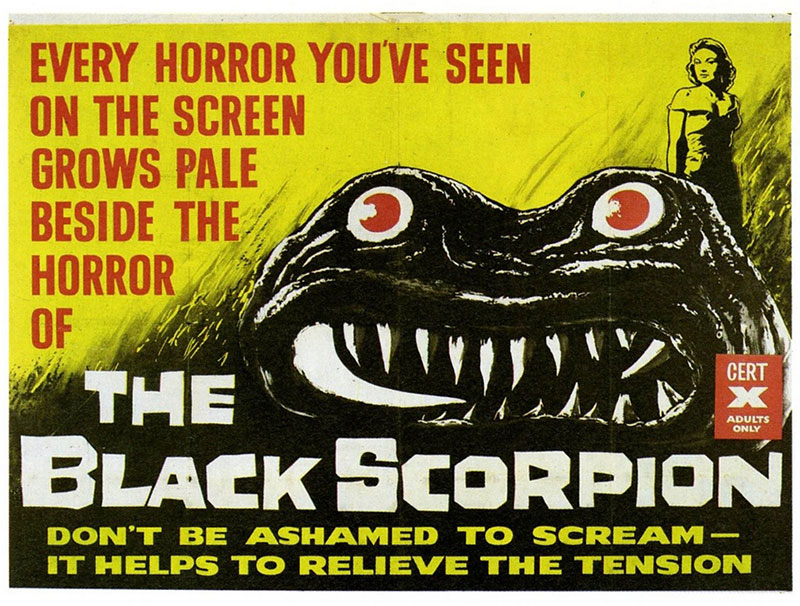 The poor performers in films like this. They come to a production, ready to put in enough work to make some mortgage payments, maybe dig a pool in the backyard, and they do a decent enough job. But then they go to the premiere of the film, with not the highest of expectations (after all, it ain’t John Ford or Howard Hawks they were working with), and they find the audience howling with laughter at the monster effects. Take a moment to appreciate the plight of the bad movie actor.
The poor performers in films like this. They come to a production, ready to put in enough work to make some mortgage payments, maybe dig a pool in the backyard, and they do a decent enough job. But then they go to the premiere of the film, with not the highest of expectations (after all, it ain’t John Ford or Howard Hawks they were working with), and they find the audience howling with laughter at the monster effects. Take a moment to appreciate the plight of the bad movie actor.
The Black Scorpion, the 1957 film from director Edward Ludwig and screenwriters David Duncan and Robert Blees, opens, as so many of these monster films from the ’50s do, with stock footage. But, for once, it’s not footage of Air Force jets or Arctic wastes. This time it’s footage of volcanoes oozing lava over the land. The expository voiceover informs the viewer that a new volcano is rising out of the ground in Mexico. In little over a month it has grown to gigantic size, threatening the surrounding ranches.
A pair of geologists, Dr. Hank Scott and Dr. Arturo Ramos (Richard Denning and Carlos Rivas), are studying the volcano when they discover that a house on the outskirts of a village has been smashed by something big. They also meet local rancher Teresa Alvarez (Mara Corday), who has been having trouble with her ranch hands. Ever since the volcano began erupting, something has been killing livestock. The ranch hands believe it to be a legendary demon bull, and have been quitting the ranch in droves. It turns out that the real menace is a nest of giant scorpions, each large enough to tower over a train car, that has been unearthed by the volcanic activity. The film follows the efforts of the cast to exterminate these giant creatures. The battle goes back and forth. Eventually cattle and villagers aren’t enough for the scorpions, and they make their way to Mexico City for the climax.
The creature effects in The Black Scorpion are a little weird. The film features numerous effects sequences of the scorpions wreaking their havoc. The sequences fall into three categories. The first are stop motion shots where models are used on a miniature set. The second is a model that the effects team used for closeups of a scorpion’s face. And the third is when a scorpion must be shown chasing down humans fleeing in the streets.
The first set of effects is done very well. Willis O’Brien, made famous by his work in King Kong, and Pete Peterson, who, with O’Brien, won an Academy Award for the effects in Mighty Joe Young, were hired to provide the effects for this film. Having so much experience with stop motion, it was to be expected that this aspect of the film would excel. The stop motion has less choppiness than in other films, and the scorpions have very quick movements. There are sequences where the giant scorpions fight each other and the suspension of disbelief comes easy.
The giant head model they used for closeups, however, looked like something out of a Roger Corman flick. It drips goo and is vaguely anthropomorphic, which is a direct contrast to the realistic looking models they used in the stop motion shots. It’s perplexing that this model was used. In fact, every frame showing the scorpion face could be excised from the film, as no other object or performer appears in these shots, and the movie would be better for it.
But it’s the third type of shot that really fails. Here, stop motion was superimposed on location shots, and the effects team couldn’t get the exposures right. Instead of a scorpion chasing down the hapless populace, a slightly transparent, featureless black shadow in the shape of a scorpion does the work. These effects are worse than those found in one of Bert I. Gordon’s flicks. The filmmakers must have been completely out of cash by the time this work was delivered, because a lack of money is the only reason I can think of that would prevent these shots being redone. They belong nowhere in a movie.
The result is a film that is not as good as it should be. Ludwig gave the film a good pace, and the material is no sillier than any other giant monster flick, but the effects really hamper the film. It would be one thing if the effects were bad throughout. But in seeing some effects done so well, and others so poorly, we viewers know what we’re missing out on.
